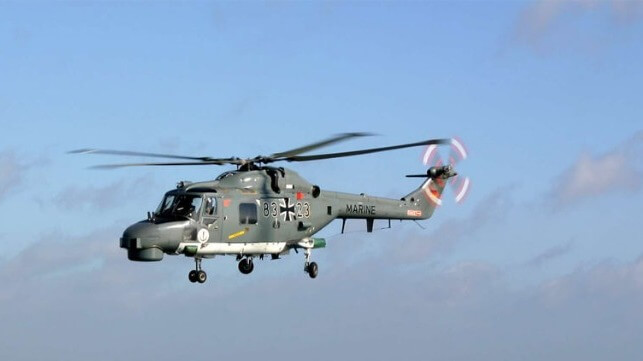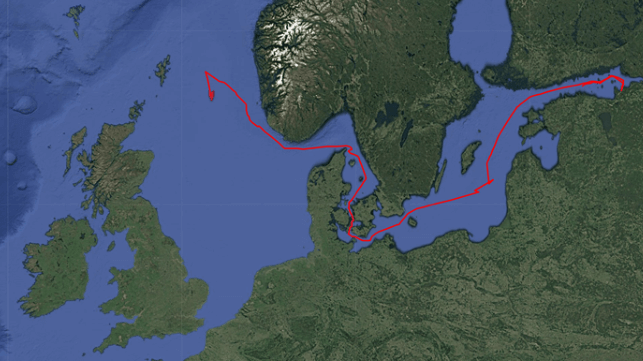NATO Wants to Use Drone Boats for Maritime Security in the Baltic

NATO's maritime forces may soon deploy unmanned systems for surveillance purposes in the Baltic, where member states have serious concerns about subsea infrastructure security.
Adm. Pierre Vandier (Marine Nationale), former chief of staff of the French Navy, heads up naval transformation for NATO. He recently told Defense News that unmanned systems could provide a "CCTV" surveillance network for maritime security hotspots, much like security systems used by police forces for shoreside law enforcement.
This concept was inspired by U.S. 5th Fleet's Task Force 59, which uses unmanned platforms to keep an eye on Iranian movements in the Persian Gulf and Strait of Hormuz. Systems like the unarmed Saildrone surveillance platform and the armed T-38 Devil Ray unmanned surface vessel have given Task Force 59 a meaningful demonstration-scale capability in the calm waters of the Middle East. Those demonstrations have informed Navy planning for full-scale unmanned deployment, which is now beginning in 5th Fleet with a manned-unmanned teaming "Task Group" trained by Task Force 59. U.S. Indo-Pacific Command has high hopes for unmanned systems in the Taiwan Strait, and the Pentagon is underwriting the rollout with its much-publicized "Project Replicator."
The need for maritime domain surveillance in the Baltic is urgent. Twice in the last two years, Chinese ships have destroyed subsea cables and other infrastructure in the Baltic by simply dragging anchor under power, plowing the bottom for dozens (or even hundreds) of miles. In 2022, unknown actors destroyed three out of the four pipes in the Nord Stream gas pipeline complex using explosives, and multiple investigations suggest that the attack was carried out by a small dive team using a recreational sailboat as a platform.
Finding these kinds of threats requires granular on-scene surveillance, starting with surface activity. "The technology is there to make this street-lighting with USVs," Adm. Vandier told Navy Times. He said that the idea has considerable support from NATO's maritime forces command, and could draw on proven platforms used by Task Force 59.
Report: Russian Vessel Shot Signal Flare at German Helicopter

German media is widely reporting an incident in the Baltic between an unnamed Russian ship and a German military helicopter on patrol. Deutsche Presse-Agentur (DPA) broke the story today, December 4, based on comments from Germany’s Foreign Minister on the sidelines of the NATO meeting in Brussels which the organization says was designed to “chart a way forward in addressing Russian sabotage.”
According to DPA, the Minister mentioned that a Russian ship in the Baltic had targeted a German helicopter without supplying any specific details. The vessel, which in some reports is said to be a tanker, fired a signal flare at the German helicopter. It is unclear if the helicopter had taken any actions toward the tanker to provoke a response.
The German Defense Ministry later refused to confirm the report. However, Minister Annalena Baerbock cited it as an example of Russian and Chinese efforts in the region. She also pointed to the recent damage to two undersea data cables believed to have been caused by a Chinese cargo ship. Last year, another Chinese vessel was suspected of dragging and losing its anchor in the Baltic which resulted in damage to gas lines. The Minister also cited the jamming of GPS systems while saying NATO and the EU needed to do more to monitor and protect pipelines, data cables, and other critical infrastructure assets.
Baerbock according to DPA also referenced the volume of shadow tankers operating in the Baltic circumventing the Western sanctions on Russian oil. It is unclear from the report if it was a shadow tanker that fired the flare but Denmark and other nations have long worried about the dangers of the shadow tanker fleet.
Hours after the report of the incident with the German helicopter, NATO Foreign Ministers announced a new agreement among NATO and its allies to protect critical infrastructure. NATO General Secretary Mark Rutte said they were working to counter Russia’s actions against NATO citing acts of sabotage carried out by both Russians and the Chinese.
“NATO will work closely together with the EU on these issues,” Rutte said in a statement at the end of the two days of meetings. He reported agreement among the ministers for a set of measures to counter Russia’s hostile and cyber activities.
Among the steps that NATO reports the members agreed to are enhanced intelligence exchange, more exercises, better protection of critical infrastructure, and improved cyber defense. He also said they would take “tougher action against Russia’s ‘shadow fleet’ of oil exporting ships.”
Rutte noted that continued support for Ukraine is a priority for NATO. He said it is ensuring that, when the time comes, Ukraine can negotiate peace from a position of strength. He further highlighted how NATO is delivering on its commitments and will increase efforts to protect European interests.
UK-Sanctioned Dark Fleet Tanker Cancels Detour Around Britain

This week, a newly-sanctioned tanker from the Russian dark fleet appeared to choose the long way around the British Isles, dodging any risk of UK enforcement actions. It was a rare detour away from the English Channel, adding to the length of the vessel's commercial voyage - but after attracting publicity with her unusual movements, Attica altered course and returned to the normal southerly route.
Last week, the British government sanctioned 30 tankers involved in the Russian oil trade, which helps finance the Kremlin's ongoing war in Ukraine. Because of the G7 price cap on Russian oil, these vessels do not have access to UK-based insurance markets, and most operate with questionable liability cover, particularly for oil spill risks. The UK has announced its intention to challenge vessels with uncertain insurance cover if they cross through British waters.
The tanker Attica (IMO 9436942) - one of the newly-sanctioned dark fleet vessels - appeared to be taking an unusual route around Scotland, according to Bloomberg. The vessel loaded at the Ust-Luga oil terminal near St. Petersburg in mid-November and got under way for a voyage out of the Baltic on Nov. 23. After a few stops and starts, she exited the Kattegat and entered the North Sea on December 2 - but instead of turning south for the English Channel, she settled on a northwesterly course that would take her north of the Shetland Islands.
Late on December 3, after Western media detected the unusual diversion, Attica turned due south, appearing to return towards a more traditional route. As of the early hours of Thursday morning, she was in the North Sea off Denmark, headed south towards the Channel.
According to her AIS signal, Attica is headed for Port Said, then likely onwards to India via the Suez Canal. Attica is owned and commercially managed by a holding company in the Seychelles, and its third-party shipmanager is headquartered in Shandong, China.
No comments:
Post a Comment